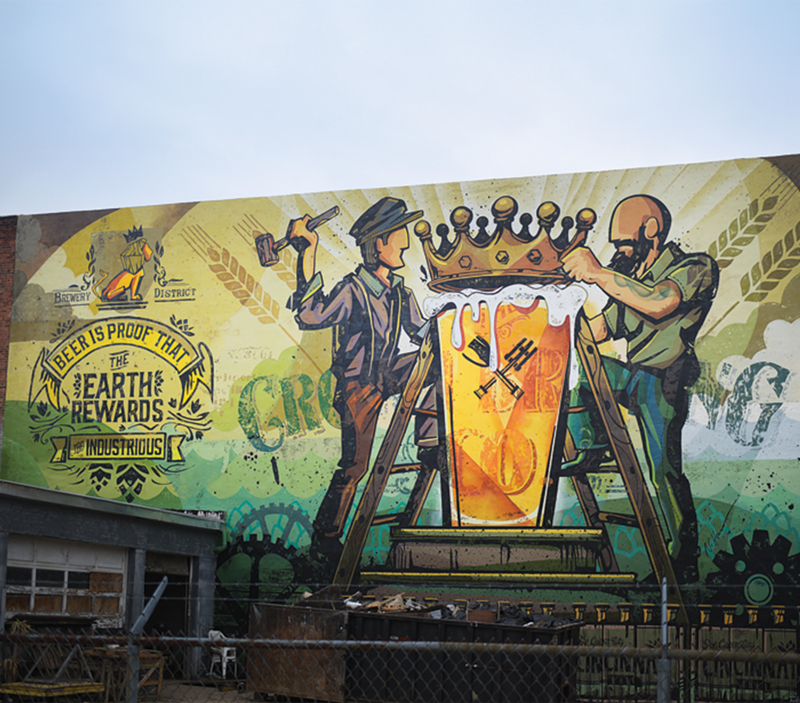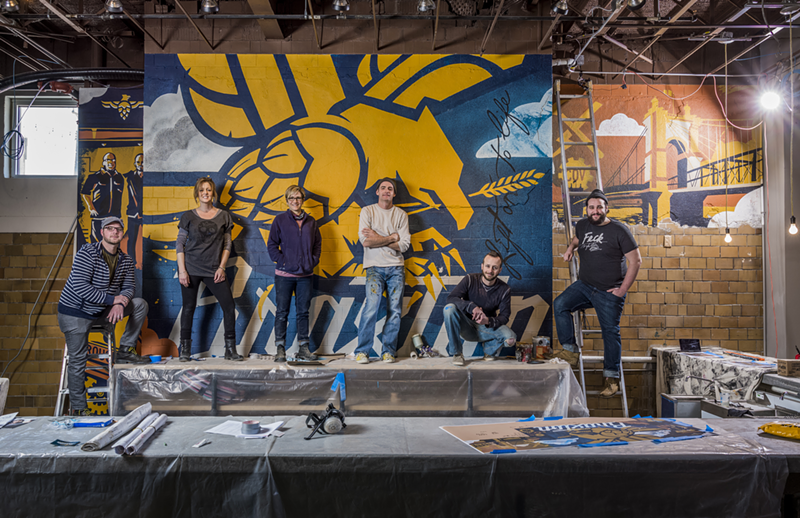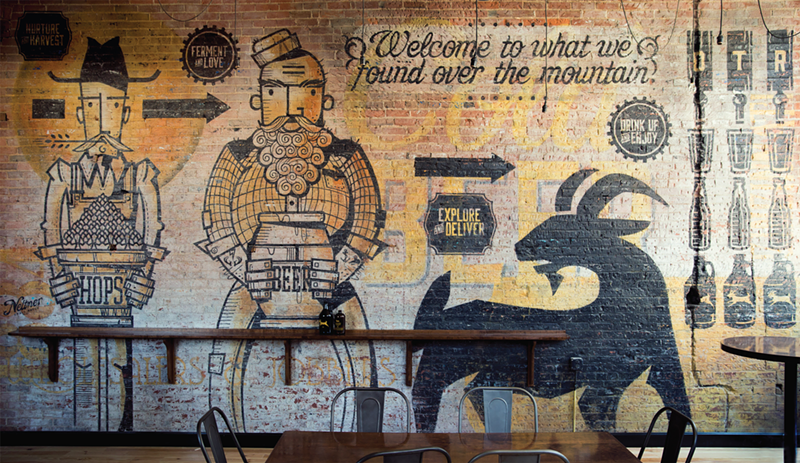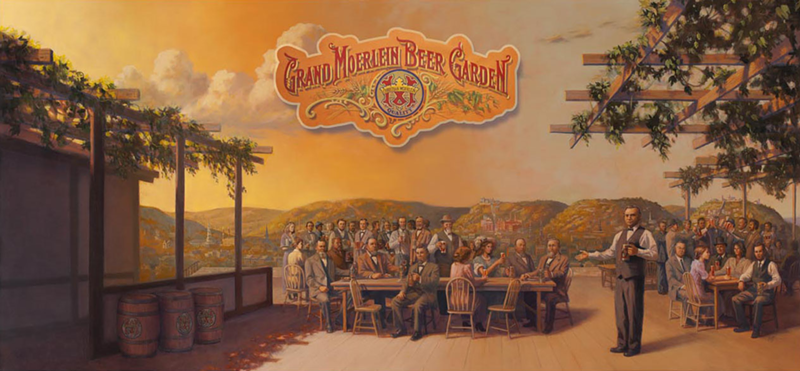W
hile live music has always mixed well with alcohol, visual bar art in Cincinnati is starting to stretch beyond portraits of dogs playing poker and glowing beer signs.
“We are seeing individuality as part of bars and breweries,” says Michael Morgan, founder and president of Queen City History & Education and author of Over-the-Rhine: When Beer Was King. “There’s a certain rejection of everything being Bud or Miller.”
The rejection is of the mass-produced — from the beers sold at bars and breweries to the art they commission. ArtWorks has tours for some of the 90 public murals they’ve created since 1996, but today local bars and breweries could have their own.
There’s the infographics mural at HalfCut in Over-the-Rhine, the classic antiquity mural at Liberty’s Bar & Bottle about five minutes north, two silk-screened enameled map drawings in Oakley’s MadTree Brewing, a three-paneled mural across the bar backsplash at Braxton Brewing Company in Covington, Ky., and more.
Rhinegeist in Over-the-Rhine is home to seven. The taproom’s first mural was photographer and artist Robin McKerrell’s work, but it was conceived from a litany of owners Bob Bonder, Bryant Goulding and Jim Matt’s inspirations — The Grand Teton mountain range, Salvador Dali, the statue of Moses by Michelangelo. The end product is a glazed, ethereal depiction of what Bonder refers to as the renaissance of Cincinnati — once home to 36 breweries in the 1870s.
This renaissance seemed to begin when Greg Hardman came down from the craft beer mountain in 2004 with the then-out-of-state-owned Schoenling Brewing Company, its labels — including Christian Moerlein — and later, 60 other Cincinnati brew brands. When he opened the Moerlein Lager House in 2012, the label’s longtime bottle label designer Jim Effler offered to use his signature oil paints to create its 13-by-30-foot mural.
From the base of the restaurant and bar’s stairwell, about 7,000 weekly customers are ushered into an early 20th century German beer garden by a stein-holding Christian Moerlein. He stands among fellow past beer barons from breweries like Hudepohl and Windisch-Muhlhauser — even newcomer Hardman.
“Beer is like artwork,” Hardman says. “A great artist can paint a beautiful mural, and a great brewer can create a delicious beer.”
If pre-Prohibition temperance advocate Carrie Nation had taken a closer look behind her hatchet during her now-infamous retreat from early 20th century’s Vine Street, she wouldn’t have seen many murals. Saloons were mostly adorned with European imports of wooden reliefs, Victorian oil paintings and patterned wallpaper.
Wallpaper, and the more expensive and less accessible murals, were considered stylish decorations in a time when walls were often tarnished by coal. Painted foliage encircled the Weidemann Brewery’s ceilings in early 20th century Newport, Ky. On Vine Street, a 5-foot-tall drunken elf danced across the main room of Wielert’s Cafe. When Prohibition began and murals went out of style, the canvas, which was attached to the wall like wallpaper, was painted over.
“We chipped off at least a quarter-inch of white paint,” says Wooden Nickel Antiques owner Michael Williams of the
Wielert’s
treasure he unearthed in the 1980s. He and wife Patty kept a section of the mural for their Walnut Hills home.
Those are the pre-Prohibition exceptions. Murals in Cincinnati, like those across the U.S., reached their height during the Great Depression, when the New Deal formed the Works Progress Administration (WPA).
In the 1930s and early ’40s, the program hired hundreds of unemployed artists across the country to create upward of 100,000 public paintings and murals — like the glass mosaics at Union Terminal and the oil paintings at Lunken Airport.
“Those murals embodied what America could be based on industry,” says Jennifer Ustick, assistant professor of art at the University of Cincinnati’s College of Design, Architecture, Art and Planning and project manager of seven ArtWorks murals, four of which she designed. “They created an identity for Cincinnati and a sense of pride.”
It was during this time that Cincinnati’s arguably most popular bar mural was created inside Grammer’s in Over-the-Rhine. While the bar was established in 1911, the panoramic view of the Rhine River Valley in Germany was painted in its first floor bar room nearly 30 years later. It likens the Rhine River to the Miami and Erie Canal, which ran across Central Parkway, creating the industry necessary for the brewery district and the neighborhood’s name.
Today, the figurative storytelling features of WPA murals are translated into the branding of local bars and breweries. It’s seen in HalfCut’s depiction of the owner’s cross-country journey to create their beerista bar and in Braxton Brewing Company’s illustration of its owners’ garage-brewing roots.
These examples, created by Keith Neltner of Neltner Small Batch, produce the same pride the WPA murals did for America through paintings of its manufacturers and historical events.
Except this time, it’s for beer.
Perhaps the embodiment of Cincinnati brewing pride comes from the mural on McMicken Avenue in Over-the-Rhine, created by ArtWorks and the Brewery District Community Urban Redevelopment Corporation. On the 2,900-square-foot wall, an early 20th century brewery worker and a current one crown the Queen City’s rightful king — a pint of beer. It’s another Neltner design, using his signature layered paint to mimic distress over time. He’s inspired by ghost signs — the faded remnants of business markers and advertisements painted on Cincinnati’s urban sites. Behind the mural’s main image, Neltner added the faded lettering of the building’s 19th century occupant, The Crown Brewery.
“The stories of craft beer are rich,” says Neltner. “Murals bring them to life.”
The mural marks the gateway of what will be the Brewing Heritage Trail in Over-the-Rhine and surrounding areas within the next three to four years.
Three large murals and a dozen smaller ones will be added to the 2.3-mile path, which describes beer’s influence on Cincinnati. This summer, ArtWorks will complete its first of two murals on Sam Adams’ brewery. The first location is on the brewery’s horizontal wall off Central Parkway in the West End. It’s easily suitable for a timeline of Cincinnati brewing history — including space for its future.
For more info on the BREWING HERITAGE TRAIL, visit brewingheritagetrail.org.









